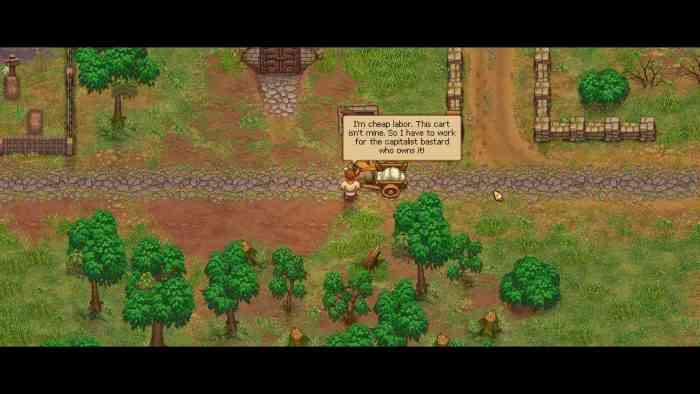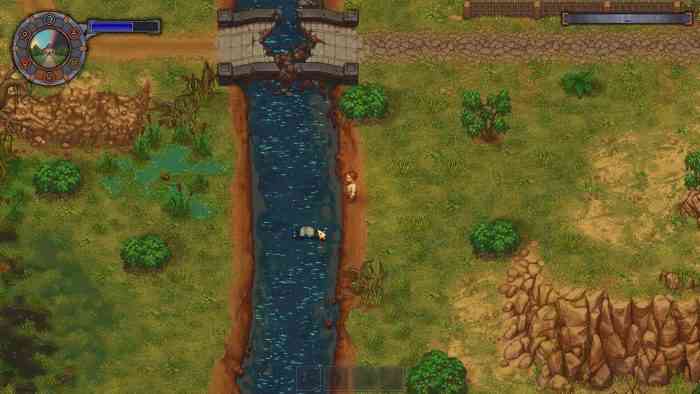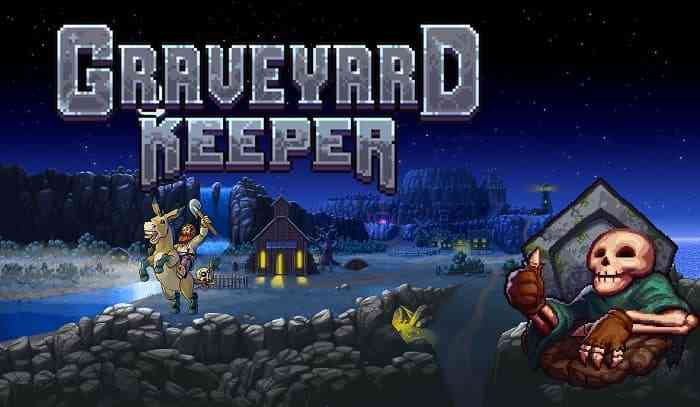Graveyard Keeper Review
Graveyard Keeper, or as I like to call it: Stardew Valley: Goth Edition, is a grim, tongue-in-cheek rendition of the resource-management sim/Harvest Moon format game from the makers of 2016’s Punch Club. And yes, you can also call it the Dark Souls of farming sims, for those who regard the measurement of time as before and after Dark Souls. It’s been out for almost a week now and was a surprise addition to Xbox Games Pass on the day it launched, giving me the opportunity to check it out on both PC and console. After spending quite a few hours with both versions of it, here’s what I think.

One Foot in the Coffin
Graveyard Keeper’s story sees our nameless main character sent back in time after getting hit by a car to a nameless medieval province, where he’s delegated by Death itself to manage and tend to a graveyard, with the help (or not) of a talking skull, a communist donkey, and a materialistic bishop, along with a plethora of other nearby townsfolk. The game does a great job of teaching the player the most important basics of graveyard keeping in the first few minutes – digging, cutting, and throwing – before sending them out into the world to spend hours upon hours of gathering resources and crafting a myriad of tools that are used to create other tools, which can be used to craft items that enhance your graveyard or complete sidequests for townspeople. The graveyard itself operates on a rating system that can be improved by crafting crosses and tiny fences for graves and burying people who were good people in life, providing you don’t butcher the crap out of it during the autopsy. However, if you do totally ruin the corpse of a formerly living and well-loved person, you can chuck it in the river instead of giving it a proper burial – I’m sure nobody will mind.

Burying bodies grants the player burial certificates, which can be sold to the bartender/mayor in the Village, though after the first hour or so, corpses become fewer and further between, making the accumulation of cash challenging to a frustrating degree seeing as nobody in the Village will buy anything you make except food for quite a while. That’s not a particularly viable strategy either though, because selling food nets very little money, and is better used to refill your energy gauge which depletes relatively quickly more often than not, which can bring resource gathering or crafting to a screeching halt, forcing the player to go to bed instead. If you manage to cheat the system and make enough food to keep your character awake for an extended period of time, the game will penalize you for having not slept by passively draining your energy, even when you’re not doing anything. I understand that this mechanic is a genre norm, but in the case of Graveyard keeper, being forced to stop to sleep, which involves watching your character do so for up to 20 seconds at a time while you do nothing, combined with the painfully slow player movement speed, is an enormous detriment to the game’s pacing, turning just about everything into a sluggish, grueling task where sleep is dreaded during every second of it – the opposite of real life, where sleep is a reward for having put up with the pain of existence for several hours straight.
One Foot in the Grave
On top of pacing issues, Graveyard Keeper makes it easy for the player to get lost and confused by not showing the player where they are on the map, and explaining things one time, and one time only. Characters don’t even have a prompt to repeat most things, including crucial information like where you’re supposed to go to meet someone integral to the story, or what each of the game’s multiple currencies actually represents. At the beginning of the game, three different currencies are introduced that allow you to unlock new blueprints and crafting recipes in a “technologies” skill tree, and despite having seen the tutorial for it twice now, I still couldn’t tell you what they’re called, other than red, green, and blue, the latter of which is the most difficult to attain, as it relies on scientific research which isn’t available for the first handful of hours. Once it is, two new currencies are introduced, faith and science. Science is attained through crafting paper and then “decomposing” it at a study table, while faith is gained by holding sermons once you’ve unlocked the church, where you hilariously run the most inoffensive and vague religion of all time.

But the best fruits of your labor are in exploration and things that make your sleep-heavy, slow-moving life easier. The first time you repair a bridge, it rewards you with an enormous new area full of resources that are slightly less scarce than they were in the main area. Poke around a little more and you’ll find a new place to set up camp and a new character in a hellish swamp maze that could test the patience of even the most tenured Buddhist monk, or a burnt house with a garden ripe for planting suspiciously close to where a witch-burning megalomaniac hangs out and tries to open an inter-dimensional portal. Combined with the game’s charming soundtrack and the satisfaction of clearing out the pathways in your basement to make a series of shortcuts to the game’s most important areas, these are the things that make Graveyard Keeper enjoyable and worth returning to. These are the “just one more thing” moments that keep the player glued to the controller, and make me wish Lazy Bear had spent a bit more time polishing the game. Frequent stuttering and short freezes break immersion and evoke a state of frustration not unlike the one induced by the painful sleep mechanic, and at one point, one of my characters lines of dialogue was “character_intro_3,” which I’m unsure if it was a bug, or if it was simply missed by play-testers.
The Verdict
Graveyard Keeper is an engaging and rewarding farming sim weighed down by pacing and performance issues. The GBA-style visuals compliment its contained open world, and influences from old-school Zelda games that shine through just as much as that of Harvest Moon or Stardew Valley. The PC and Xbox versions play almost exactly the same, which is unfortunate considering the game’s performance, but if you can look past all the spots and blotches, you’ll likely enjoy the challenging gathering-crafting grind, and the game’s macabre humor when it actually lands.
***A PC key was provided by the publisher***
The Good
- Exploration is Fun and Rewarding
- Dark Sense of Humor
- Charming Visuals
The Bad
- Performance Issues
- Sleep Mechanic Hurts Pacing
- Easy to Get Lost and Confused

